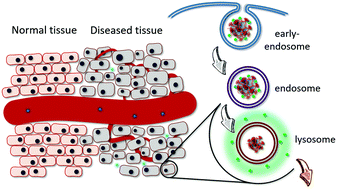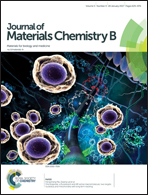Rational design of dendritic thermoresponsive nanogels that undergo phase transition under endolysosomal conditions†
Abstract
In the last few decades, the synthesis of nanodevices has become a very active research field with many applications in biochemistry, biotechnology, and biomedicine. However, there is still a great need for smart nanomaterials that can sense and respond to environmental changes. Temperature- and pH-responsive nanogels (NGs), which are prepared in a one-pot synthesis from N-isopropylacrylamide (NiPAm) and a Newkome-type dendron (ABC) bearing carboxylic acid groups, are being investigated as multi-responsive drug carriers. As a result, NGs have been developed that are able to undergo a reversible volume phase transition triggered by acidic conditions, like the ones found in endolysosomal compartments of cancer cells. The NGs have been thoroughly characterized using dynamic light scattering and spectroscopies, such as infrared, nuclear magnetic resonance, UV-visible, and stimulated Raman. Strong hydrogen bonds have been detected when the ABC moieties are deprotonated, which has led to changes in the transition temperatures of the NGs and a reversible, pH-dependent aggregation. This pH-dependent phase change was exploited for the effective encapsulation and sustained release of the anticancer drug cisplatin and resulted in a faster release of the drug at endolysosomal pH values. The cisplatin-loaded NGs have exhibited high toxicities against A549 cells in vitro, while the unloaded NGs have been found to be not cytotoxic and hemocompatible.


 Please wait while we load your content...
Please wait while we load your content...